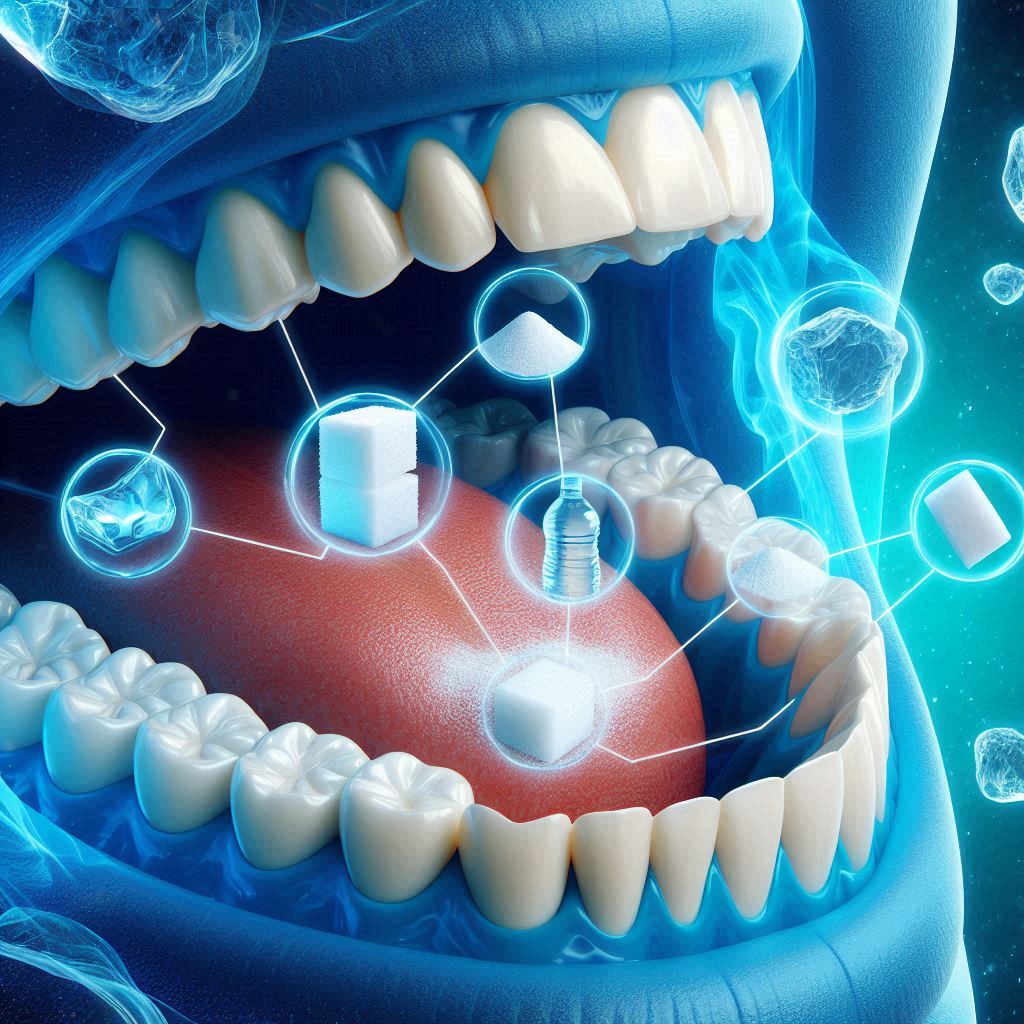Introduction
Good oral hygiene is a crucial part of maintaining overall health, yet the world’s most common chronic disease—dental cavities—remains widespread. The root cause of cavities is multifactorial, but one of the most influential factors is the consumption of sugar. Sugars, especially refined sugars, are the primary food source for bacteria in the mouth that are responsible for tooth decay. These bacteria break down sugars to produce acid, which erodes enamel and leads to cavities. But how does sugar really affect our teeth? What exactly happens inside the mouth after we eat sugar? And how can we protect our teeth from the damaging effects of sugar?
In this guide, we will explore the relationship between sugar and tooth decay in depth. We will examine the biology and mechanics of cavities, explain the role of sugar, and offer insights into practical solutions for avoiding the long-term effects of sugar consumption on dental health.
Understanding Tooth Anatomy and How Cavities Form
Before diving into the details of sugar’s effects on teeth, it’s important to understand the structure of a tooth and how the decay process works.
Structure of a Tooth
A tooth is composed of multiple layers:
- Enamel: The tooth’s outermost layer, made up of tightly packed hydroxyapatite crystals, a mineral compound primarily composed of calcium and phosphate. It is the hardest substance in the human body, providing a protective shield for the underlying layers. Enamel is designed to endure the forces of chewing and grinding, enabling the tooth to function effectively. However, despite its strength, enamel is brittle and can be worn down or compromised by prolonged exposure to acids. These acids are primarily produced when bacteria in the mouth ferment sugars, leading to the gradual erosion of enamel. Over time, repeated acid attacks can weaken enamel, making it more vulnerable to cavities.
- Dentin: Underneath the enamel lies dentin, a softer, less mineralized layer of tissue that is more susceptible to decay once the enamel is damaged. Dentin is yellowish in color and contains microscopic tubules that extend from the enamel to the pulp of the tooth. These tubules can be exposed when the enamel breaks down, and when this happens, the tooth can become sensitive to temperature changes or pressure, causing discomfort. As decay progresses deeper into the tooth, it can spread through the dentin, worsening the damage.
- Pulp: The pulp is the deepest part of the tooth, housing nerves, blood vessels, and connective tissue. It plays a crucial role in the tooth’s nourishment and sensation. When a cavity progresses deep enough to reach the pulp, it can cause intense pain due to the exposure of nerves. The bacteria from the cavity can also infect the pulp, leading to an abscess or more severe infection. If this happens, the tooth may become severely compromised. In such cases, a root canal treatment is often necessary. This procedure removes the infected pulp, cleans the area, and seals it to prevent further damage, potentially saving the tooth from extraction.
How Cavities Form
Cavities, or dental caries, develop when the enamel is demineralized by acids produced by oral bacteria that feed on sugar. The process of cavity formation unfolds in several stages:
- The Plaque Formation:
- Bacteria naturally live in the mouth, forming a sticky, colorless film called plaque. This plaque builds up on teeth and contains bacteria like Streptococcus mutans, which are capable of metabolizing sugars.
- Bacterial Metabolism of Sugar:
- When sugary foods or drinks are consumed, the sugar interacts with the plaque bacteria. These bacteria metabolize sugar to produce acids, such as lactic acid, which lower the pH in the mouth.
- Acid Attack on Enamel:
- The lower pH caused by bacterial acid production leads to the demineralization of enamel. This is a slow, ongoing process that begins immediately after sugar is consumed and continues for up to 20 minutes or longer.
- Cavity Development:
- If the acid exposure is not neutralized, the enamel starts to break down and small pits begin to form. If untreated, these pits deepen and expose the underlying dentin, which accelerates the decay process.
- Spread to Dentin and Pulp:
- As the cavity progresses, it can move through the enamel into the softer dentin. Eventually, the infection can reach the pulp, causing tooth abscesses and leading to intense pain. This stage may require professional intervention, like a root canal.
How Sugar Directly Contributes to Cavities
The direct relationship between sugar consumption and cavity formation lies in the ability of sugar to fuel bacterial activity in the mouth. Here’s how sugar contributes to cavities:
- The Bacterial Fermentation of Sugar:
- Certain bacteria in the mouth, particularly Streptococcus mutans, thrive on sugar. These bacteria ferment sugar to produce lactic acid. The acidity of this byproduct is the primary cause of enamel demineralization.
- The more sugar available, the more acid is produced, which accelerates the demineralization of enamel.
- The Frequency of Acid Attacks:
- Not only the amount of sugar consumed but also the frequency matters. Frequent sugar consumption leads to a continuous acid attack on the teeth. For example, sipping sugary beverages throughout the day causes a prolonged acid attack, which is much more harmful than consuming a large amount of sugar all at once.
- Sticky and Liquid Sugars:
- Sticky foods (like candy, cookies, and caramel) adhere to the teeth, providing a long-lasting food source for bacteria. Sugary drinks (like soda, fruit juices, and sweetened coffee) also expose the teeth to sugar for extended periods, contributing to decay.
- Even if you rinse your mouth with water afterward, the sugar residues can stay on teeth and continue to fuel bacteria.
The Role of Diet in the Development of Cavities
While sugar is the primary dietary culprit in tooth decay, other aspects of the diet can either exacerbate or mitigate the risk of cavities.
Factors that Influence the Impact of Sugar on Teeth
- Calcium and Phosphate:
- Calcium is a mineral that plays a significant role in strengthening tooth enamel. Foods like dairy products, leafy greens, and fortified cereals provide calcium that helps remineralize enamel.
- Phosphate works similarly, and the combination of calcium and phosphate helps to form strong enamel, making it more resistant to acid attacks.
- Fluoride:
- Fluoride strengthens enamel by making it more resistant to acid. Fluoride is commonly added to toothpaste and drinking water. Studies have shown that communities with fluoridated water have significantly lower rates of tooth decay.
- Vitamin D:
- Vitamin D is essential for calcium absorption and for ensuring healthy teeth. Without enough vitamin D, calcium cannot be properly absorbed into the body, leaving enamel weak and prone to decay.
- Sugar Substitutes and Their Effect:
- Sugar substitutes, such as xylitol, can be beneficial because they do not feed harmful bacteria. Some studies even suggest that xylitol can help reduce the growth of Streptococcus mutans and decrease cavity risk.
Factors that Influence Sugar’s Impact on Cavities
While sugar consumption is a key factor in the development of cavities, other elements can influence how much damage sugar does to teeth. Some of these factors include:
- Frequency of Sugar Consumption: It’s not just the amount of sugar consumed but also how frequently sugar is consumed that impacts oral health. The more often sugary substances are in contact with teeth, the more frequently acid production occurs. Snacking on sugary foods throughout the day can lead to prolonged periods of acid exposure, making teeth more vulnerable to decay.
- Oral Hygiene Habits: Proper brushing and flossing can help reduce the amount of sugar left in the mouth and prevent bacteria from feeding on it. Without good oral hygiene, bacteria have more time to act on sugar particles and produce harmful acids.
- Saliva Production: Saliva plays an essential role in neutralizing acids in the mouth and remineralizing the enamel. A reduced flow of saliva (due to dehydration, medications, or certain medical conditions) can increase the likelihood of cavities forming, as the natural cleaning mechanism is compromised.
- Type of Sugar: Not all sugars are created equal. Some types of sugar, like refined sugars found in candy and soda, are more easily metabolized by bacteria, leading to faster acid production. Other sugars, like those in whole fruits, tend to be less harmful due to their fiber content and the way they are processed by the body.
Consequences of Excessive Sugar Consumption: Long-Term Dental Damage
Excessive and prolonged sugar consumption can lead to significant, irreversible dental damage. Let’s explore the long-term consequences of sugar on oral health.
- Enamel Erosion:
- Enamel erosion is one of the most serious effects of sugar on teeth. Once enamel is worn away, it cannot regenerate, leading to increased sensitivity and a higher risk of cavities.
- Enamel erosion also makes teeth more prone to staining and discoloration, affecting both aesthetic appearance and long-term dental health.
- Gum Disease:
- The bacteria that feed on sugar do not only attack enamel. They can also contribute to the formation of gum disease. Gingivitis and periodontitis are the result of bacterial growth at the gum line, causing inflammation, bleeding, and potentially leading to tooth loss if left untreated.
- Tooth Sensitivity:
- As enamel erodes, the underlying dentin becomes exposed, leading to tooth sensitivity. People with sensitive teeth may experience pain when consuming hot, cold, or sugary foods.
- Once the dentin is exposed, it becomes much more susceptible to decay and can cause more severe issues down the line.
- Tooth Loss and Abscesses:
- In extreme cases, untreated cavities can progress to the point where they infect the tooth pulp. This leads to abscesses, severe pain, and the need for extraction.
- If untreated, abscesses can spread to the surrounding bone and tissue, leading to further health complications, including systemic infections.
Preventing Cavities and Minimizing Sugar’s Impact
Preventing cavities is far easier and more affordable than treating them, and the best prevention starts with understanding how to minimize sugar’s impact. Here’s how you can help protect your teeth from the effects of sugar:
Strategies for Reducing Sugar Intake
- Eat a Balanced Diet:
- Avoiding excessive sugar and instead focusing on a balanced diet rich in vitamins, minerals, and fiber helps maintain optimal oral health. Vegetables, fruits, whole grains, nuts, and seeds can all play a part in keeping teeth healthy.
- Limit processed foods and sugary snacks that stick to teeth and increase the risk of tooth decay.
- Rinse and Drink Water After Eating:
- Water helps wash away sugar residues and neutralizes acids in the mouth, which reduces the length of time teeth are exposed to harmful acids.
- Drinking water with meals, especially sugary beverages, can help keep your mouth clean.
- Brush and Floss Regularly:
- Brushing twice a day with fluoride toothpaste and flossing once a day ensures that sugar and plaque are removed before they can lead to cavities.
- Regular brushing helps to remove bacteria and plaque from hard-to-reach areas between the teeth.
- Use Fluoride and Sugar-Free Products:
- Fluoride toothpaste and mouth rinses can help protect enamel and prevent cavities. Fluoride remineralizes enamel, reversing early signs of tooth decay and preventing cavities from worsening.
- Sugar-free chewing gum containing xylitol has been shown to stimulate saliva production, which helps to neutralize acids in the mouth.
- Limit Sugary Foods and Drinks: The less sugar you consume, the less time your teeth are exposed to harmful acids. Opt for healthier snacks like fruits, vegetables, or nuts instead of sugary snacks and sodas.
- Visit the Dentist Regularly: Routine dental check-ups allow your dentist to catch any issues early, providing timely intervention before cavities worsen.
Conclusion
Sugar plays a significant role in the development of dental cavities, but understanding its impact and taking preventive steps can help minimize the damage. By practicing good oral hygiene, following a balanced diet, and making smarter choices regarding sugar intake, you can protect your teeth from decay. While occasional sugar consumption may not cause immediate harm, regular or excessive sugar intake—especially without proper oral care—can lead to serious, irreversible damage.
Sugar fuels harmful bacteria in the mouth that produce acids, which gradually wear down tooth enamel and lead to cavities. To minimize the effects of sugar, it’s essential to brush your teeth twice daily with fluoride toothpaste, floss regularly, and use mouthwash when needed. A healthy diet rich in calcium, phosphate, and fluoride can strengthen enamel, while avoiding excessive sugary foods and drinks will reduce your risk of cavities. Limiting sugary snacks and beverages and choosing healthier alternatives, such as fruits or nuts, can further help maintain oral health. Routine dental check-ups are also crucial for early detection and treatment of any issues before they worsen. Ultimately, protecting your teeth requires a balanced approach to sugar consumption, consistent oral care, and regular visits to the dentist. With these habits in place, you can keep your teeth healthy and avoid the long-term consequences of tooth decay.
SOURCES
Featherstone, J.D.B. (2000). The science and practice of caries prevention. Journal of the American Dental Association, 131(7), 887-899.
Burt, B.A., & Eklund, S.A. (2005). Dentistry, dental practice, and the community (6th ed.). Saunders Elsevier.
Marsh, P.D., & Kleinberg, I. (2012). Microbiology of dental caries and periodontal disease. In M. E. R. L. M. R. B. (Ed.), Oral Microbiology and Immunology (pp. 120-137). Blackwell Publishing.
Kidd, E.A.M. (2004). The dental restoration: An update. British Dental Journal, 196(6), 337-344.
Tenovuo, J.O. (1998). The role of salivary defense factors in the prevention of dental caries. Caries Research, 32(2), 116-122.
Tanner, A.C.R., Kressin, N.R., & Kornman, K.S. (2015). The role of bacteria in the development of dental caries. In P.D. Marsh, & P. M. C. S. S. (Eds.), Microbial ecology of the oral cavity (pp. 159-170). Springer.
Featherstone, J.D.B. (2004). The continuum of dental caries—Evidence for a dynamic disease process. Journal of Dental Research, 83(2), 139-143.
HISTORY
Current Version
February 6, 2025
Written By:
SUMMIYAH MAHMOOD




